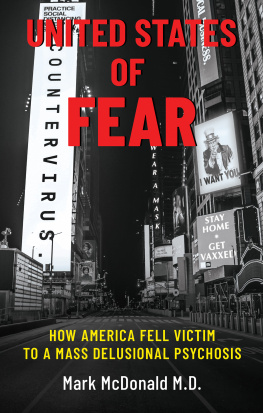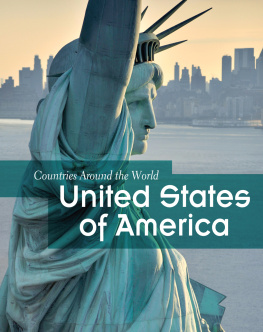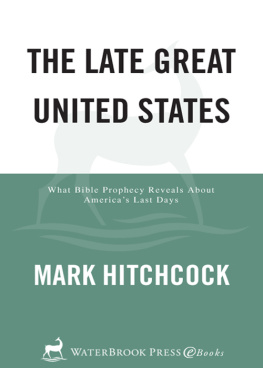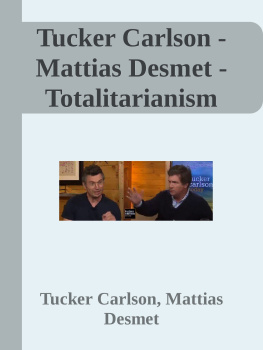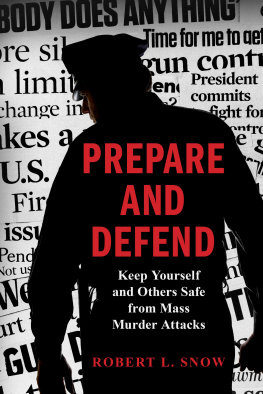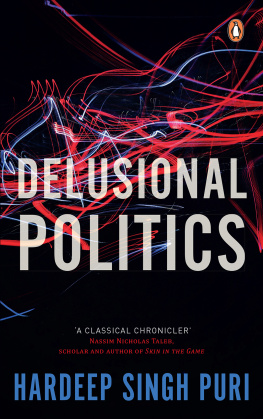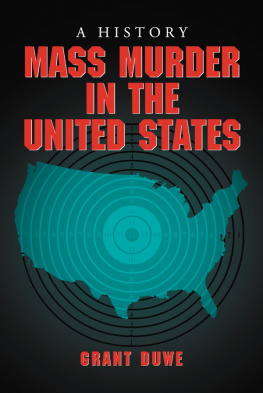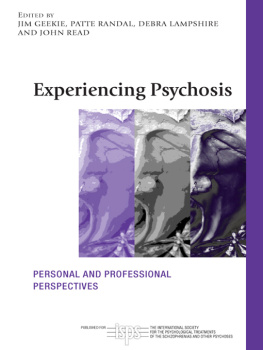Mark McDonald - United States of Fear: How America Fell Victim to Mass Delusional Psychosis
Here you can read online Mark McDonald - United States of Fear: How America Fell Victim to Mass Delusional Psychosis full text of the book (entire story) in english for free. Download pdf and epub, get meaning, cover and reviews about this ebook. year: 2021, publisher: Bombardier Books (November 8, 2021), genre: Home and family. Description of the work, (preface) as well as reviews are available. Best literature library LitArk.com created for fans of good reading and offers a wide selection of genres:
Romance novel
Science fiction
Adventure
Detective
Science
History
Home and family
Prose
Art
Politics
Computer
Non-fiction
Religion
Business
Children
Humor
Choose a favorite category and find really read worthwhile books. Enjoy immersion in the world of imagination, feel the emotions of the characters or learn something new for yourself, make an fascinating discovery.
- Book:United States of Fear: How America Fell Victim to Mass Delusional Psychosis
- Author:
- Publisher:Bombardier Books (November 8, 2021)
- Genre:
- Year:2021
- Rating:4 / 5
- Favourites:Add to favourites
- Your mark:
- 80
- 1
- 2
- 3
- 4
- 5
United States of Fear: How America Fell Victim to Mass Delusional Psychosis: summary, description and annotation
We offer to read an annotation, description, summary or preface (depends on what the author of the book "United States of Fear: How America Fell Victim to Mass Delusional Psychosis" wrote himself). If you haven't found the necessary information about the book — write in the comments, we will try to find it.
Mark McDonald: author's other books
Who wrote United States of Fear: How America Fell Victim to Mass Delusional Psychosis? Find out the surname, the name of the author of the book and a list of all author's works by series.
United States of Fear: How America Fell Victim to Mass Delusional Psychosis — read online for free the complete book (whole text) full work
Below is the text of the book, divided by pages. System saving the place of the last page read, allows you to conveniently read the book "United States of Fear: How America Fell Victim to Mass Delusional Psychosis" online for free, without having to search again every time where you left off. Put a bookmark, and you can go to the page where you finished reading at any time.
Font size:
Interval:
Bookmark:
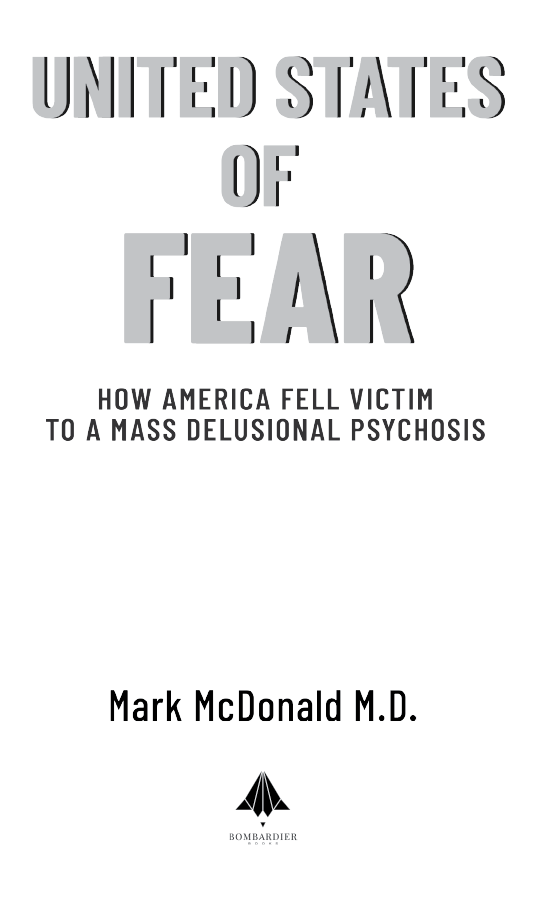
PUBLISHED BY BOMBARDIER BOOKS
An Imprint of Post Hill Press
ISBN: 978-1-63758-319-7
ISBN (eBook): 978-1-63758-320-3
United States of Fear:
How America Fell Victim to a Mass Delusional Psychosis
2021 by Mark McDonald, M.D.
All Rights Reserved
Cover Design by Tiffani Shea
No part of this book may be reproduced, stored in a retrieval system, or transmitted by any means without the written permission of the author and publisher.


Post Hill Press
New York Nashville
posthillpress.com
Published in the United States of America
Contents
I n the summer of 2020 , the mother of a fifteen-year-old boy with ADHD declined to bring him to my office for his three-month medication follow-up visit. We havent been going out much recently, she explained. The boy had been my patient for eight years, and I had seen him regularly every ninety days throughout that entire period. He came from a rather typical, upper-middle-class West Los Angeles family with two parents. He was an only child. He was a good student and quite sociable, with no significant problems other than his ADHD, which had been well-managed for many years. His mother had always appeared anxious and somewhat controlling. I found his father to be warm, easygoing, and calm if a bit passive and unassertive. All three were likable people who had never challenged any of my clinical recommendations.
After insisting that an in-person visit would be necessary for optimal care, I suggested she drop him off at the building instead. He was old enough to come upstairs by himself. This launched her into a hysterical rant about the dangers of her son walking through a public building and the health risk he would assume, not to mention the possibility of the family contracting a terrifying, highly contagious disease.
Despite evidence to the contrarythat children are essentially immune to the Chinese Wuhan virus and even act as barriers to its spreadshe insisted that I was uninformed, unreasonable, and cruel for demanding that her son come to my office in person to discuss his medications. A day later, I received another email, this one from her husband, apologizing on behalf of his wife, thanking me for helping care for their son all these years, but announcing that they would be seeking a new psychiatrist.
Reading between the lines, I interpreted his message to be, My wife is hysterical, and there is nothing I can do about it. To preserve our marriage, I must go along with her demand to switch doctors to someone who will treat him over Zoom and keep him under house arrest until she regains her senses.
From these brief exchanges, it was clear to me that a previously anxious woman had deteriorated into a delusional state, and that her husband could not find the courage to manage her in any helpful way, so he chose to collude with her pathology rather than take charge of his own family.
I am a psychiatrista medical doctor. I have evaluated and treated both children and adults for psychiatric illness for over ten years, in a variety of settings that have included in-patient hospitals, residential treatment programs, and jails. For the past eight years, my focus has been outpatient care, mainly through my solo clinical practice in Los Angeles. This has allowed me to offer medication treatment and talk therapy, or a combination of both. Treating children has been of particular interest to me, which is why I earned a second board certification in child and adolescent psychiatry.
I have seen thousands of patients. Several hundred fill my current practice. Most have been with me for at least two years, and many for five years or more. I always treat my patients with honesty and respect, but I do challenge them, make every effort not to collude with their pathology, and set the expectation that they do the work necessary to get better. My treatment philosophy is that acknowledging truth and reality is essential for a patient to make real progress. This acknowledgement often makes the patient uncomfortable and can even cause real suffering. But there is no shortcut to growth, and self-deception only serves as an obstacle to psychological wellness.
Fear is not new to me. I treat many children and adults who are, at some level, afraid. They express their fear through anxiety, phobias, obsessions and compulsions, and even psychosis. Fear is not a bad thing, in and of itself. Like pain, fear serves to protect us from injury. Without it, human beings would be prone to taking unnecessary risks and all wind up dead before even reproducing. Fearless humans are quickly removed from the gene pool through natural selection.
But fear can also be harmful when it arrives at the wrong time, for the wrong reason, or beyond the length of time that it is needed. We all know someone who suffers from chronic or neuropathic pain, conditions that bring such a degree of suffering to life that existence itself often becomes intolerable. Daily life cannot be enjoyed due to the constant distraction of physical pain. Far from being protective, this sort of pain condition is nothing short of extended torture.
On an emotional level, pathologic fear produces the same resultit paralyzes one from engaging with life. When fear no longer protects from harm but simply inhibits one from living fully, it ceases to be helpful. When fear becomes the primary driver of decision-making, the quality of our decisions begins to suffer.
Although every one of us lives with a degree of fear, for some people, the fear becomes so great, so impairing, so insufferable, that they come to me looking for a solution. Whether its insomnia, panic attacks, obsessions and compulsions, or melancholic depression, that solution often involves medication, some form of talk therapy, or both.
Pathological fear not only harms the individualit also harms families, communities, and society at large. A child who cannot sleep through the night due to regular nightmares will prevent his parents from sleeping. An overly cautious driver on the freeway will provoke accidents that harm and possibly kill people nearby.
The effects magnify when groups of people become caught up in fear. One well-known consequence: To prevent the possibility of even minor injury, playground equipment in many schools and parks has been removed, depriving children of the opportunity to grow and develop through play.
In the extreme, when fear spreads throughout an entire society, the effect is paralyzing. Decision-making becomes irrational and reactive. The sensationalizing of outlier events and the pursuit of safety supplants sound public policy. Media begin covering the fear story and serving it to their audience on a regular basis. Fear-driven official pronouncements evoke more fear among the citizenry, who demand more protection from politicians. A vicious cycle ensues. Mass hysteria develops, and people lose their capacity to think and act rationally.
This becomes dangerous, similar to the way a mob functionsacting on pure groupthink and raw emotion. Its a form of developmental regression that hobbles society. Unfortunately, there is no cure for fear on a societal level. The only way to address it is individually, one patient at a time.
Although psychiatric illness is to a large degree biologically driven by genetics, diet, and exercise, environment plays a significant role in generating trends. Children and adolescents, for example, suffer more anxiety today than when I began my career. Although there are multiple reasons for this, the most important one, from my perspective as a clinician, is the rise of social media. Regardless of the country studied, the adolescent population shows a predisposition to internet and cell phone addiction, which strongly correlates with sleep deficit, anxiety, stress, and depression. Since I began working predominantly with young people in 2010, I have seen a steady, gradual worsening of emotional functioningparticularly in elementary-school-age patientsas cell phone use has expanded. Its not uncommon now for fourth- and fifth-graders to carry their own phones with them. Many pull them out of their pockets reflexively the moment they sit down in my office, burying their faces in the little screen.
Next pageFont size:
Interval:
Bookmark:
Similar books «United States of Fear: How America Fell Victim to Mass Delusional Psychosis»
Look at similar books to United States of Fear: How America Fell Victim to Mass Delusional Psychosis. We have selected literature similar in name and meaning in the hope of providing readers with more options to find new, interesting, not yet read works.
Discussion, reviews of the book United States of Fear: How America Fell Victim to Mass Delusional Psychosis and just readers' own opinions. Leave your comments, write what you think about the work, its meaning or the main characters. Specify what exactly you liked and what you didn't like, and why you think so.

